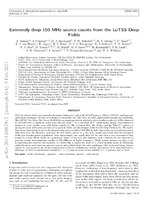| dc.description.abstract | With the advent of new generation low-frequency telescopes, such as the LOw Frequency ARray (LOFAR), and improved calibration techniques, we have now started to unveil the subgigahertz radio sky with unprecedented depth and sensitivity. The LOFAR Two Meter Sky Survey (LoTSS) is an ongoing project in which the whole northern radio sky will be observed at 150 MHz with a sensitivity better than 100 Jy beam1 at a resolution of 600. Additionally, deeper observations are planned to cover smaller areas with higher sensitivity. The Lockman Hole, the Boötes, and the Elais-N1 regions are among the most well known northern extra-galactic fields and the deepest of the LoTSS Deep Fields so far. We exploited these deep observations to derive the deepest radio source counts at 150 MHz to date. Our counts are in broad agreement with those from the literature and show the well known upturn at 1 mJy, mainly associated with the emergence of the star-forming galaxy population. More interestingly, our counts show, for the first time a very pronounced drop around S-2 mJy, which results in a prominent “bump” at sub-mJy flux densities. Such a feature was not observed in previous counts’ determinations (neither at 150MHz nor at a higher frequency). While sample variance can play a role in explaining the observed discrepancies, we believe this is mostly the result of a careful analysis aimed at deblending confused sources and removing spurious sources and artifacts from the radio catalogs. This “drop and bump” feature cannot be reproduced by any of the existing state-of-the-art evolutionary models, and it appears to be associated with a deficiency of active galactic nuclei (AGN) at an intermediate redshift (1 < z < 2) and an excess of low-redshift (z < 1) galaxies and/or AGN. | en_US |

